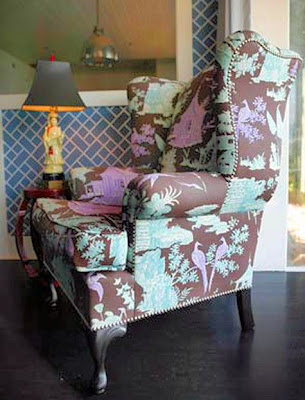M Design Interiors, Quadrille, PB Teen and Melissa Rufty Interiors
|
|
|
|
|---|
Wednesday, June 30, 2010
To Brighten Your Day
M Design Interiors, Quadrille, PB Teen and Melissa Rufty Interiors
Monday, June 28, 2010
Shop Local
Sunday, June 27, 2010
Worlds Away

Thursday, June 24, 2010
Interview with Jimmy Moore
I do recall making at least one mistake. When discussing heart attacks,I said "atrial fibrillation" when I meant "ventricular fibrillation".
Tuesday, June 22, 2010
Urban Dwelling
In Search of Traditional Asian Diets
Given the difficulty of growing rice in most places, and hand milling it, the modern widespread consumption of white rice in Asia must be a 20th century phenomenon, originating in the last 20-100 years depending on location. Therefore, white rice consumption does not predate the emergence of the "diseases of civilization" in Asia.
In the book Western Diseases: Their Emergence and Prevention, there are several accounts of traditional Asian diets I find interesting.
Taiwan in 1980
The staple constituent of the diet is polished white rice. Formerly in the poorer areas along the sea coast the staple diet was sweet potato, with small amounts of white rice added. Formerly in the mountains sweet potato, millet and taro were the staple foods. During the last 15 years, with the general economic development of the whole island, white polished rice has largely replaced other foods. There is almost universal disinclination to eat brown (unpolished) rice, because white rice is more palatable, it bears kudos, cooking is easier and quicker, and it can be stored for a much longer period.
Traditionally, coronary heart disease and high blood pressure were rare, but the prevalence is now increasing rapidly. Stroke is common. Diabetes was rare but is increasing gradually.
Mainland China
China is a diverse country, and the food culture varies by region.
Snapper (1965)… quoted an analysis by Guy and Yeh of Peiping (Peking) diets in 1938. There was a whole cereal/legume/vegetable diet for poorer people and a milled-cereal/meat/vegetable diet for the richer people.
Symptoms of vitamin A, C and D deficiency were common in the poor, although coronary heart disease and high blood pressure were rare. Diabetes occurred at a higher rate than in most traditionally-living populations.
Japan
On the Japanese island of Okinawa, the traditional staple is the sweet potato, with a smaller amount of rice eaten as well. Seafood, vegetables, pork and soy are also on the menu. In Akira Kurosawa’s movie Seven Samurai, set in 16th century mainland Japan, peasants ate home-processed millet and barley, while the wealthy ate white rice. Although a movie may not be the best source of information, I assume it has some basis in fact.
White Rice: a Traditional Asian Staple?
It depends on your perspective. How far back do you have to go before you can call a food traditional? Many peoples' grandparents ate white rice, but I doubt their great great grandparents ate it frequently. White rice may have been a staple for the wealthy for hundreds of years in some places. But for most of Asia, in the last few thousand years, it was probably a rare treat. The diet most likely resembled that of many non-industrial Africans: an assortment of traditionally prepared grains, root vegetables, legumes, vegetables and a little meat.
Please add any additional information you may have about traditional Asian diets to the comments section.














































.jpg)









